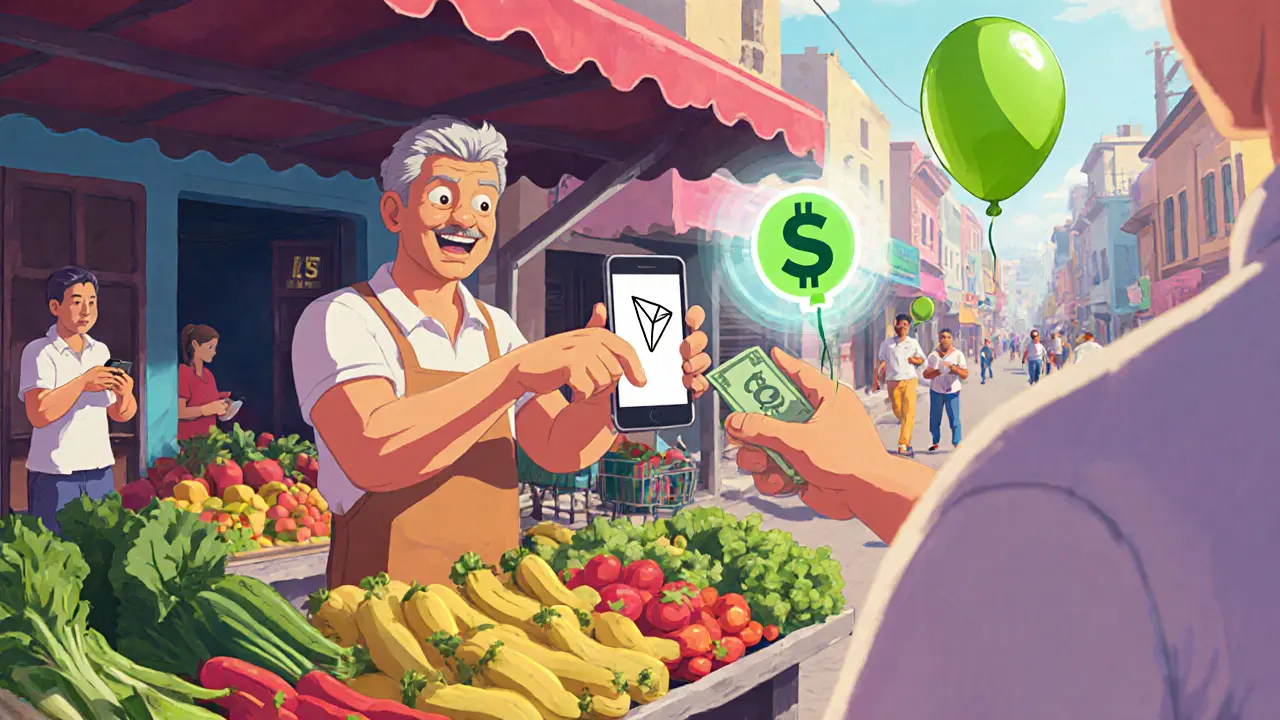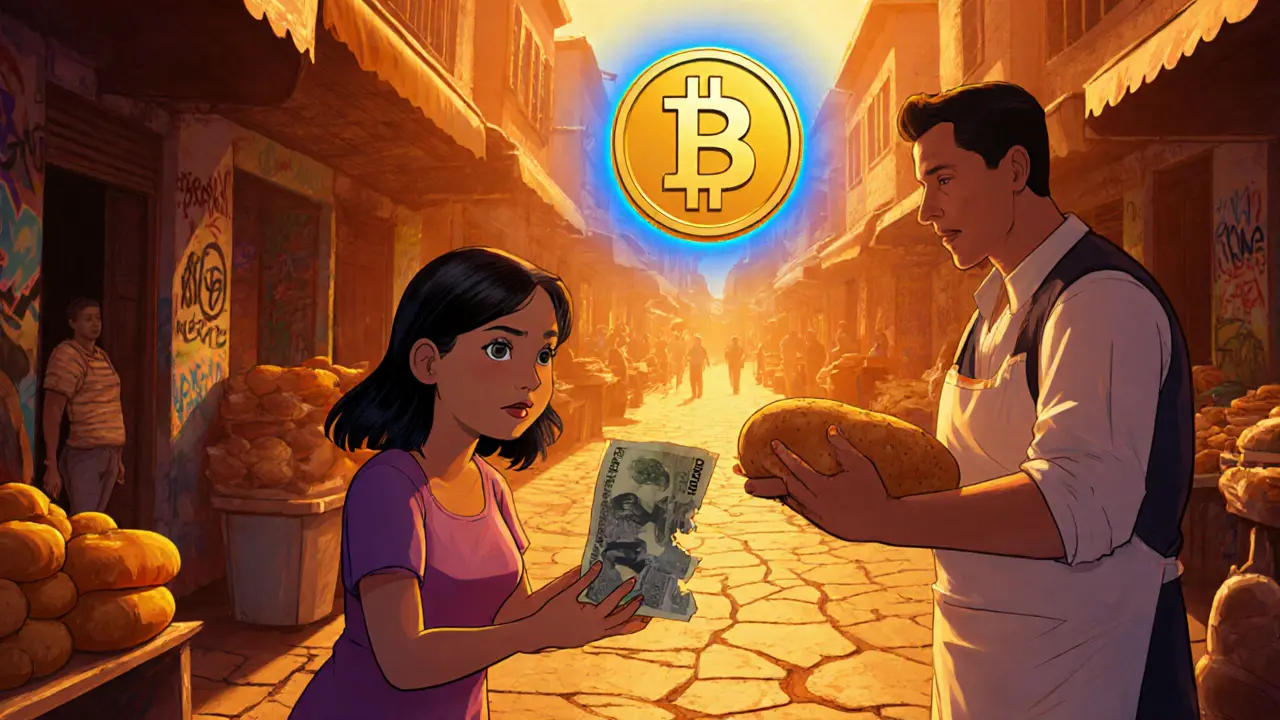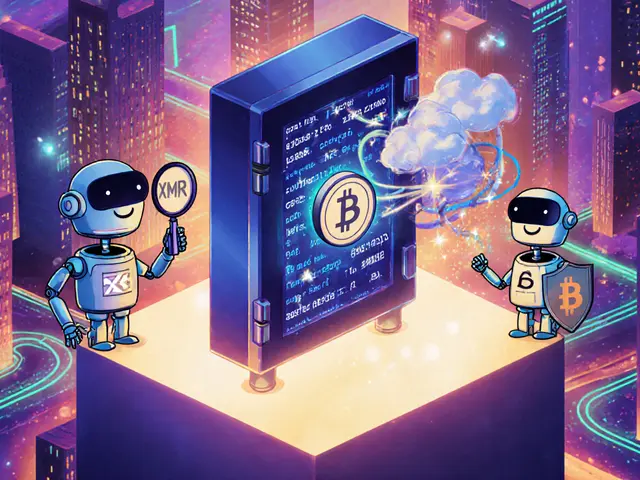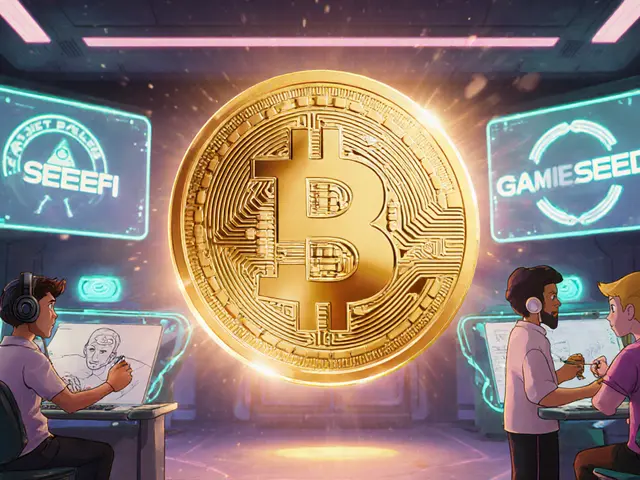Venezuela Hyperinflation Value Calculator
Venezuela's annual inflation rate was 229% in 2024. This calculator shows how much value is lost with the bolívar versus preserved with USDT.
Value Analysis
With 229% annual inflation:
USDT maintains a 1:1 peg to USD, providing stability during hyperinflation. This calculation assumes 1 USDT = 1 USD.
Imagine trying to buy a loaf of bread while the money in your wallet loses half its value every month. That’s the reality for most Venezuelans today, and it’s why Bitcoin adoption has exploded faster than any hype cycle in the country.
Key Takeaways
- Venezuela’s annual inflation topped 229% in 2024, pushing millions toward Bitcoin and USDT as a hedge.
- Stablecoins, especially USDT, dominate daily transactions because they stay pegged to the U.S. dollar.
- P2P platforms like Binance P2P and LocalBitcoins are the backbone of the crypto ecosystem, serving users without traditional banks.
- Adoption is driven by necessity, not speculation, and urban merchants now accept crypto for up to 65% of sales.
- Future growth hinges on sanctions relief, stablecoin regulation, and regional payment integration.
The Economic Collapse That Sparked a Digital Exodus
When the Venezuelan bolívar stopped defending its value in October 2023, the exchange rate plummeted by more than 70% within eight months. The Venezuelan Finance Observatory recorded 229% inflation in May 2024, and wages barely kept pace. With banks crippled by U.S. sanctions and cash shortages becoming the norm, citizens needed a way to preserve buying power.
Venezuela is a South American nation facing a protracted economic crisis marked by hyperinflation, severe currency devaluation, and limited access to foreign exchange. The desperation created fertile ground for cryptocurrency digital assets that can be transferred without relying on traditional banking infrastructure. among the population.
Why Bitcoin Became the First Digital Lifeline
Bitcoin’s scarcity-capped at 21million coins-offers a predictable store of value, something the bolívar lacks. Early adopters used it to move money across borders, protect savings, and pay for basics when local cash was worthless.
According to Chainalysis’ 2024 Crypto Adoption Index, Venezuela ranked 13th globally, with a 110% year‑over‑year rise in crypto usage. Private‑sector Bitcoin transactions hit $119million in July 2025, a clear sign that the asset moved from niche speculation to a daily utility.
Stablecoins: The Practical Workhorse
While Bitcoin offers long‑term scarcity, daily commerce demands price stability. That’s where stablecoins-tokens pegged to fiat currencies-come in. USDT (Tether) now handles roughly 91% of Venezuelan crypto transactions, according to SUNACRIP data processed by AInvest.
USDT (Tether) a dollar‑pegged stablecoin that provides near‑instant transaction settlement on multiple blockchain networks. Users call it “Binance dollars” because most trades happen on Binance’s P2P platform.
USDT’s typical confirmation time on the Tron network is under two minutes, far quicker than Bitcoin’s 10‑60minute windows during network congestion. For a street vendor buying vegetables, that speed makes the difference between a sale and a loss.

How People Are Actually Using Crypto
Peer‑to‑peer platforms are the engine of the ecosystem. Binance P2P commands about 63% of trading volume, while LocalBitcoins holds another 22%.
Binance a global cryptocurrency exchange that offers a peer‑to‑peer marketplace enabling direct trades between users. provides Spanish‑language guides, a mobile wallet, and in‑app escrow that protects both buyer and seller.
LocalBitcoins, despite lower user ratings (3.1/5), remains popular in rural pockets where Binance’s services are blocked by sanctions.
Digital wallets like Binance Wallet and Airtm have reached an estimated 4.3million Venezuelans-about 13% of the population. The learning curve is steep but doable; a study from Universidad Central de Venezuela showed most new users become proficient within three weeks.
Concrete Numbers: Adoption in Context
| Metric | Value |
|---|---|
| Annual inflation (2024) | 229% |
| Bitcoin transaction volume (July2025) | $119million |
| USDT share of crypto transactions | 91% |
| Remittances using crypto (2023) | $461million (9% of total) |
| Merchants accepting crypto (Caracas survey) | 65% |
| Population with smartphone access | 68% |
| Reliable internet connectivity | 45% |
Benefits vs. Pitfalls: What the Data Shows
Benefits
- Inflation hedge: USDT maintains a 1:1 peg to the dollar, protecting everyday purchases.
- Cross‑border remittances: Crypto accounted for $461million in 2023, bypassing costly traditional channels.
- Access without banks: Over 4million users can store value without needing a bank account.
Pitfalls
- Sanctions risk: U.S. restrictions have blocked roughly 18% of attempted Binance transactions.
- Centralized stablecoin exposure: Tether controls 76% of the stablecoin market, creating a single‑point failure.
- Connectivity challenges: 37% of users report transaction delays due to slow internet.
EconomistDavid Lipton warned that “digital assets provide tactical relief but cannot substitute for sound monetary policy,” echoing the sentiment that crypto is a bandaid, not a cure.
Living Proof: Voices from the Streets
Victor Sousa, a Caracas resident, told the Financial Times that buying phone accessories with USDT felt like “paying with real money again.” He plans to keep his savings in crypto once the market stabilizes.
Carlos, another user, explained on Reddit’s r/BitcoinVenezuela that “I use USDT for everything-food, rent, transport. It’s far more reliable than the bolívar.”
However, not every story is rosy. A survey by Markets.com found that 22% of respondents struggled to convert crypto back into physical goods during network outages, highlighting the fragility of the system when connectivity dips.
Future Outlook: From Survival Tool to Parallel Economy?
Short‑term forecasts suggest crypto will stay vital until inflation dips below 50% annually-a target unlikely before 2027, according to IMF analysts. Long‑term success depends on three variables:
- Regulatory clarity: Venezuela’s 2020 Crypto Assets Law remains vague, and U.S. sanctions could tighten further.
- Stablecoin decentralization: Emerging community‑run stablecoins could reduce reliance on Tether.
- Regional payment integration: Participation in the BRICS cross‑border payment initiative may provide a sanctions‑resistant alternative.
If these pieces fall into place, crypto could evolve from a stop‑gap into a formal parallel payment network, potentially linking with a future stable national currency. If not, the current boom may collapse, leaving users exposed to centralized stablecoin risks without the crisis that once justified their use.
Comparison: Bitcoin vs. USDT vs. Petro
| Attribute | Bitcoin (BTC) | USDT (Tether) | Petro (PTR) |
|---|---|---|---|
| Price stability | Highly volatile (price driven by global markets) | 1USD peg (±0.5% typical) | Oil‑linked, collapsed in 2024 |
| Transaction speed (average) | 10‑60minutes (network dependent) | Under 2minutes (Tron) | Few minutes (private chain) |
| Adoption rate (2025) | ~12% of informal economy | ~91% of crypto transactions | Negligible post‑2024 |
| Regulatory risk | Targeted by sanctions but still accessible via P2P | Subject to U.S. sanctions on issuer | State‑controlled, high political risk |
What You Can Do Today (If You’re Inside or Curious About Venezuela)
- Start with a low‑fee wallet like Binance Wallet; the platform offers Spanish tutorials and in‑app escrow.
- Buy USDT on Binance P2P using a local payment method (e.g., cash deposit at an authorized store) to lock in dollar value.
- Test a small peer‑to‑peer trade on LocalBitcoins to understand the escrow process before scaling up.
- Follow community channels such as “Cripto Para Todos” on YouTube for step‑by‑step guides.
- Stay aware of sanction updates; if a transaction fails, try a decentralized exchange like Bisq as a fallback.
Frequently Asked Questions
Why is USDT more popular than Bitcoin for everyday purchases?
USDT stays pegged to the U.S. dollar, so its price remains stable even when the bolívar is inflating wildly. That predictability makes it useful for buying groceries, paying rent, or sending remittances, whereas Bitcoin’s price can swing 10% in a day.
Can I use Bitcoin to send money abroad without a bank?
Yes. By creating a Bitcoin wallet, you can transfer funds to another wallet anywhere in the world. The recipient can then convert the BTC to local currency or stablecoins through a P2P platform.
What are the biggest risks of relying on crypto in Venezuela?
The main risks are sanctions that can block exchanges, reliance on centralized stablecoins like USDT, and unreliable internet that can delay or fail transactions. Users also face conversion fees that spike during network congestion.
How can I protect myself from price volatility when using Bitcoin?
Many Venezuelans convert Bitcoin to USDT almost immediately after buying, using the stablecoin for daily spending. Keeping the bulk of savings in USDT or another stablecoin reduces exposure to Bitcoin’s swings.
Is there any government plan to regulate crypto?
Venezuela’s 2020 Crypto Assets Law is vague, and the Central Bank’s 2024 report merely acknowledges crypto’s role without setting rules. The regulatory environment remains uncertain, with sanctions adding another layer of complexity.




Comments
Man i just saw a video of some dude in Caracas buying a whole week's worth of groceries with USDT on his phone and it hit me like a truck
we complain about inflation here and it's like 3%
these people are living in a parallel universe where money is a joke and crypto is the only thing keeping them alive
no hype no crypto bros just pure survival
it's beautiful and terrifying at the same time
Let’s be real - this isn’t adoption it’s desperation dressed up as innovation
the U.S. dollar is the real hero here not some blockchain magic
you don’t need Bitcoin you need a functioning central bank and a government that doesn’t print money like confetti
crypto is a bandaid on a gunshot wound and pretending otherwise is naive at best and dangerous at worst
My cousin lived in Caracas for a year and she told me about how her neighbor started a little bakery and only took USDT
she said the first time she saw someone pay for empanadas with a QR code she cried
it wasn’t about tech it was about dignity
they weren’t chasing wealth they were just trying to feed their kids without watching their money vanish before noon
that’s the real story here
Okay so let me break this down for the people who think crypto is some kind of miracle cure because they saw a reddit post
first off USDT is not decentralized it’s a private company with opaque reserves and if Tether goes down or gets sanctioned which it absolutely will the entire Venezuelan crypto economy collapses overnight
second Bitcoin is too slow and too volatile for daily use so people use USDT which means they’re still dependent on a centralized entity
third the 65% merchant adoption rate sounds impressive until you realize that’s only in Caracas and Maracaibo and the rest of the country still uses cash or barter
and fourth the internet connectivity is 45% so half the population can’t even access this system
so what we have here is not an economic revolution it’s a fragile patchwork of privilege and luck held together by Binance’s escrow system and a whole lot of hope
and don’t even get me started on the Petro fiasco that was just a scam wrapped in blockchain jargon
Bro why are you even talking about this like it’s some heroic movement
it’s just people scrambling because their government failed
why are you making this sound like a tech win when it’s just a cry for help
also i tried to use Binance once and got scammed so i don’t trust any of this anyway
just let them use dollars like normal people
There’s something deeply human about this
people aren’t adopting crypto because it’s cool or profitable
they’re adopting it because it’s the only thing left that doesn’t lie to them
the bolívar promised value and delivered nothing
Bitcoin doesn’t promise anything - it just exists
and for the first time in years that’s enough
it’s not a solution to the crisis
but it’s proof that people still know how to adapt when everything else fails
and maybe that’s the real story
USDT works because it’s simple
you trade cash for it you spend it
no math no guessing
and the fact that it’s faster than Bitcoin means it actually gets used
the real question is why hasn’t this happened everywhere else
if a country with 45% internet and hyperinflation can make this work
what’s stopping the rest of us from trying